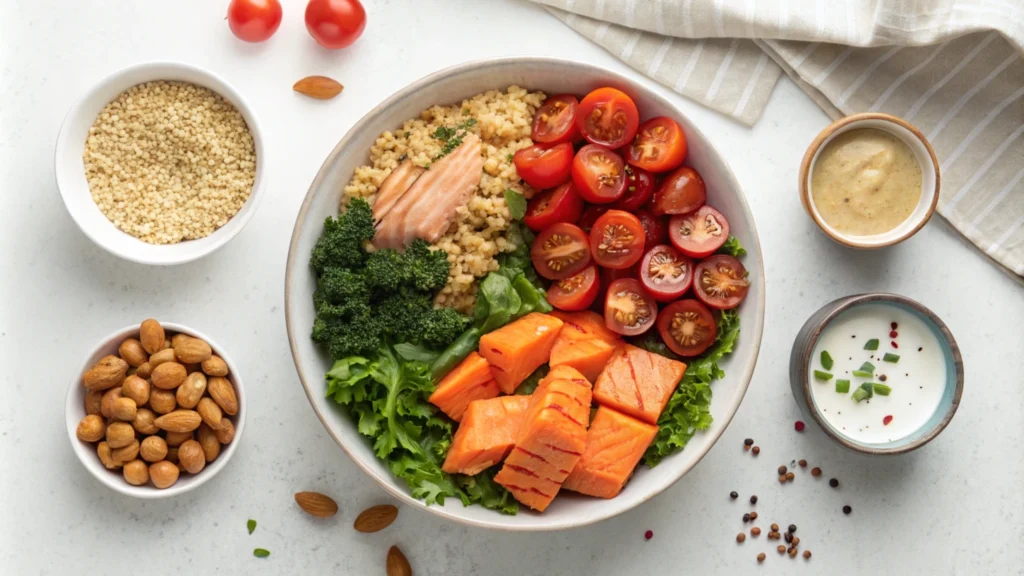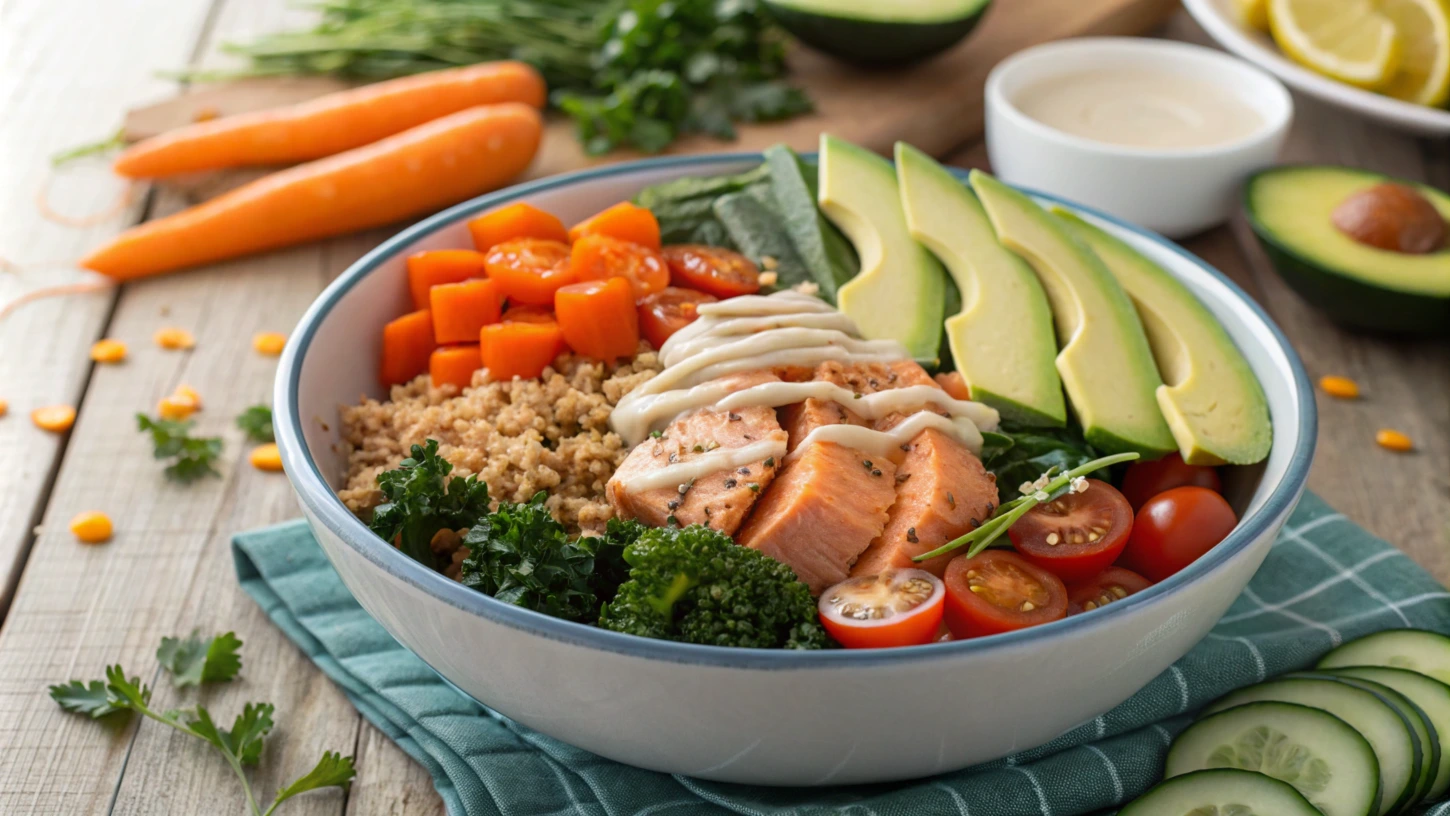For busy people who want to eat healthily, save time, and keep to a budget, meal prep makes life so much easier. The canned salmon Buddha bowl is one of the healthiest and most adaptable options. This dish combines a variety of grains, fresh vegetables, and strong flavors with the health benefits of omega-3 fatty acids. Additionally, it’s simple to make and ideal for anyone wishing to improve their weekly meal preparation schedule. To help you become an expert at meal prep with a canned salmon Buddha bowl, we’ll go into great detail about the ingredients, preparation techniques, customization possibilities, and even some inventive pairings in this guide. Additionally, we’ll use internal links to provide more recipe ideas from Charmed Recipes for a more Extra meal idea.
Table of Contents
What Is a Buddha Bowl?
Often called a “power bowl” or “nourish bowl,” is a dish made up of a variety of vibrant and nutrient-rich ingredients. The name, for instance, is thought to originate from the concept of a bowl so full that it resembles a Buddha’s rounded belly. As a result, these bowls are highly adaptable and can include grains, proteins, vegetables, and toppings, all brought together by a flavorful dressing. What’s more, the appeal of Buddha bowls lies in their versatility. They can cater to any dietary preference whether it’s gluten-free, vegan, or high-protein. Additionally, they are perfect for meal prep since they stay fresh for several days in the fridge. Therefore, they’re an ideal option for individuals who want to enjoy delicious, healthy meals without much hassle.
Why Choose a Canned Salmon Buddha Bowl?

Nutritional Benefits
Canned salmon is a nutritional powerhouse, packed with omega-3 fatty acids, high-quality protein, and essential vitamins like B12 and D. These nutrients are known to support heart health, brain function, and muscle repair, making it an excellent addition to a balanced diet. Omega-3s, in particular, are renowned for their anti-inflammatory properties and their ability to improve cardiovascular health, cognitive function, and joint flexibility. A clever way to take advantage of these advantages in a tasty, convenient format that works for any lifestyle is to include canned salmon in a Buddha bowl. For example, eating omega-3-rich fish is associated with better heart health and decreased inflammation, according to the Academy of Nutrition and Dietetics, making it an important part of a healthy diet. Additionally, it’s a flexible ingredient that complements grains, veggies, and dressings to make every meal as nourishing as it is tasty.
Affordable and Eco-Friendly
In addition to being reasonably priced, canned salmon is an environmentally friendly option. which guarantees environmentally friendly fishing methods that preserve marine environments. Canned salmon is ideal for cutting down on food waste because it has a longer shelf life than fresh salmon. As a result, it’s a great pantry essential for economical meal preparation.
Ingredients for the Perfect Canned Salmon Buddha Bowl

Crafting a delicious and well-balanced Buddha bowl starts with selecting the right ingredients. Above all, balance is key.
1. Base Grains
The base of your Buddha bowl provides complex carbohydrates and fiber to keep you full and energized. Some excellent options include:
- Quinoa: High in protein and gluten-free.
- Brown Rice: A budget-friendly option rich in fiber.
- Farro: A nutty and chewy grain with a higher protein content.
- Low-Carb Alternatives: Cauliflower rice or spiralized zucchini noodles for those watching their carb intake.
2. Protein
This dish’s main ingredient is canned salmon. It goes well with practically any flavor profile, is precooked, and is simple to season. The salmon only needs to be drained, seasoned, and flaked for the ideal garnish. It’s also a protein-rich choice that works well with meal preparation.
3. Vegetables
Vegetables add color, texture, and essential nutrients. Aim for a mix of fresh and roasted veggies:
- Raw: Spinach, kale, shredded carrots, cherry tomatoes.
- Roasted: Sweet potatoes, zucchini, broccoli, bell peppers.
4. Toppings
Toppings are where you can get creative. Add crunch, flavor, and even more nutrients with:
- Toasted nuts (almonds, walnuts) or seeds (sunflower, sesame).
- Avocado slices for creaminess.
- Pickled onions or jalapeños for a tangy kick.
- Crispy chickpeas for added protein and crunch.
5. Dressings
The dressing ties the entire bowl together. Some popular options include:
- Tahini dressing for a nutty, creamy flavor.
- Lemon vinaigrette for a light, zesty touch.
- Soy-ginger dressing for an Asian-inspired twist.
- Sriracha mayo for a spicy kick.
Together, these components create a balanced and flavorful dish.
Check out Spicy Canned Salmon Salad Rice Bowl from allrecipes for more inspiration.
How to Prepare and Assemble Your Buddha Bowl

Creating a Buddha bowl is simple, but proper preparation is key to ensuring fresh and flavorful results. Follow these steps for meal prep success:
1. Prep Your Ingredients
- Cook your grains according to package instructions, then let them cool completely to prevent sogginess during storage.
- Drain and lightly season canned salmon with salt, pepper, and optional spices like paprika or cumin.
- Wash and chop fresh vegetables. Roast any desired veggies with olive oil, salt, and pepper for added depth of flavor.
2. Layer the Bowl
- Start with a hearty layer of grains or low-carb alternatives as the base.
- Add the seasoned salmon as the protein-rich focal point.
- Top with a variety of vegetables for vibrant colors and textures.
- Sprinkle on your toppings and keep dressings separate until ready to eat.
3. Storage Tips
- Store the bowls in airtight containers in the fridge. They’ll stay fresh for up to four days.
- Keep the dressing in a small container to maintain the texture of your ingredients until serving.
For more ideas on building a balanced meal, check out this recipe for Pumpkin Banana Loaf, which incorporates nutrient-dense ingredients in a creative way.
Customizing Your Canned Salmon Buddha Bowl

The beauty of a Buddha bowl is its versatility. Here are some ways to customize it:
Flavor Profiles
- Asian-Inspired: Add edamame, shredded cabbage, and a soy-ginger dressing.
- Mediterranean: Use olives, roasted red peppers, cucumbers, and tzatziki.
- Spicy Kick: Include jalapeños, sriracha mayo, and roasted poblano peppers.
Dietary Adjustments
- Gluten-Free: Choose quinoa or cauliflower rice.
- Vegan: Swap salmon for marinated tofu, tempeh, or roasted chickpeas.
- Low-Carb: Focus on leafy greens and non-starchy vegetables.
For more creative recipes, explore the idea of pairing bold and subtle flavors with Earl Grey Cookies, a perfect example of flavor fusion.
Advanced Tips for Meal Prepping Buddha Bowls
Batch Cooking

Cook grains and roast vegetables in large batches to save time and streamline your meal prep process. This method gives you ready-to-use, adaptable ingredients that you can mix and match for different meals all week long. By planning ahead, you can make healthy eating more accessible and stress-free by reducing the amount of work required to prepare meals each day and ensuring that you have wholesome, tasty ingredients on hand for easy assembly.
Freezing Components
While individual ingredients like cooked grains and roasted vegetables freeze incredibly well, fully assembled Buddha bowls don’t because the texture of fresh ingredients like leafy greens and raw vegetables is lost. To preserve their flavor and quality, simply portion them into freezer bags or airtight containers, making sure they are completely cooled before freezing. When it’s time to eat, you can quickly thaw these ingredients in the microwave or refrigerator and mix them with fresh ingredients like avocado, crisp vegetables, or your preferred dressing. In addition to saving time, this technique guarantees that your food will remain flavorful and fresh even if it is prepared ahead of time.
Spice Blends
To spice up your bowls, try using different spice blends like za’atar, garam masala, or everything bagel seasoning. To suit your tastes, you can also create your own spice blends by combining chili flakes, cumin, garlic powder, and smoked paprika. With their vivid colors and textures, these blends not only improve the flavor but also the aesthetic appeal. You won’t grow tired of your meal preparation routine because each bowl will feel different, taste different, and be customized to your own preferences.
You Can Use Canned Salmon Instead of Fresh
Canned salmon makes a great substitute for fresh salmon. It has similar nutrients, including omega-3 fatty acids, protein, and vitamins. While the texture may vary slightly, canned salmon fits well in many dishes like salads, sandwiches, and Buddha bowls. It’s affordable, easy to use, and has a long shelf life. Canned salmon doesn’t require cooking, so it’s perfect for quick meals and meal prep.
How to Eat Canned Salmon
To get the most out of canned salmon, drain and flake it before using. You can add it to a salad, mix it into pasta, or even make salmon patties. Another great option is to mix it with grains and fresh veggies for a healthy bowl. The possibilities are endless, and canned salmon pairs well with a variety of ingredients, making it an easy addition to your meals.
Is It Safe to Eat Canned Salmon Every Day?
Eating canned salmon every day is safe in moderation. It provides protein, omega-3 fatty acids, and essential vitamins, but it’s also high in sodium. To reduce your sodium intake, opt for low-sodium canned salmon. While canned salmon has low mercury levels, it’s still a good idea to balance your protein sources. Eating it a few times a week is a healthy choice.
Canned Salmon is Cooked Before Canning
Canned salmon is already cooked before it’s sealed in the can. The fish undergoes a cooking process, such as steam or pressure cooking, which preserves it and makes it safe to eat right away. This process also helps maintain the fish’s nutrients. While the texture may differ from fresh salmon, canned salmon is still a convenient, healthy option for your meals.
FAQs About Canned Salmon Buddha Bowls
How long can Buddha bowls be stored?
Properly stored, then they last up to four days in the fridge. Keep dressings separate for maximum freshness.
Can I freeze Buddha bowls?
It’s best to freeze components like grains and roasted vegetables separately, as fresh veggies may lose their texture after thawing.
Are canned salmon Buddha bowls healthy?
Absolutely! They’re packed with omega-3 fatty acids, lean protein, and fiber-rich vegetables, making them a balanced and nutrient-dense meal.
How do I prevent sogginess?
Layer ingredients strategically and store dressings separately to keep your bowls crisp and fresh.
Conclusion
For meal preparation, a canned salmon Buddha bowl is a practical, wholesome, and adaptable choice. It is the ideal option for time-pressed people who wish to eat healthily while saving time because it blends the health advantages of omega-3 fatty acids with fresh vegetables, grains, and robust flavors. It is perfect for meal prep because of its versatility, which enables customization according to dietary requirements, and its ability to remain fresh for several days. The canned salmon Buddha bowl is a simple and tasty way to add some flair to your weekly routine, regardless of your level of experience with meal preparation or your desire for new ideas.

